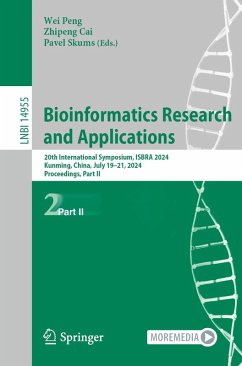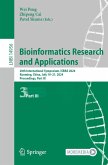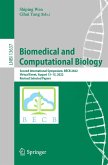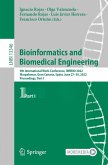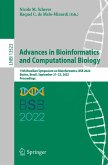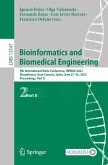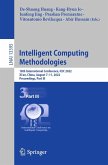Bioinformatics Research and Applications (eBook, PDF)
20th International Symposium, ISBRA 2024, Kunming, China, July 19-21, 2024, Proceedings, Part II
Redaktion: Peng, Wei; Skums, Pavel; Cai, Zhipeng
121,95 €
121,95 €
inkl. MwSt.
Sofort per Download lieferbar

61 °P sammeln
121,95 €
Als Download kaufen

121,95 €
inkl. MwSt.
Sofort per Download lieferbar

61 °P sammeln
Jetzt verschenken
Alle Infos zum eBook verschenken
121,95 €
inkl. MwSt.
Sofort per Download lieferbar
Alle Infos zum eBook verschenken

61 °P sammeln
Bioinformatics Research and Applications (eBook, PDF)
20th International Symposium, ISBRA 2024, Kunming, China, July 19-21, 2024, Proceedings, Part II
Redaktion: Peng, Wei; Skums, Pavel; Cai, Zhipeng
- Format: PDF
- Merkliste
- Auf die Merkliste
- Bewerten Bewerten
- Teilen
- Produkt teilen
- Produkterinnerung
- Produkterinnerung

Bitte loggen Sie sich zunächst in Ihr Kundenkonto ein oder registrieren Sie sich bei
bücher.de, um das eBook-Abo tolino select nutzen zu können.
Hier können Sie sich einloggen
Hier können Sie sich einloggen
Sie sind bereits eingeloggt. Klicken Sie auf 2. tolino select Abo, um fortzufahren.

Bitte loggen Sie sich zunächst in Ihr Kundenkonto ein oder registrieren Sie sich bei bücher.de, um das eBook-Abo tolino select nutzen zu können.
This book constitutes the refereed proceedings of the 20th International Symposium on Bioinformatics Research and Applications, ISBRA 2024, held in Kunming, China, in July 19-21, 2024.
The 93 full papers included in this book were carefully reviewed and selected from 236 submissions. The symposium provides a forum for the exchange of ideas and results among researchers, developers, and practitioners working on all aspects of bioinformatics and computational biology and their applications.
- Geräte: PC
- ohne Kopierschutz
- eBook Hilfe
- Größe: 44.17MB
Andere Kunden interessierten sich auch für
![Bioinformatics Research and Applications (eBook, PDF) Bioinformatics Research and Applications (eBook, PDF)]() Bioinformatics Research and Applications (eBook, PDF)121,95 €
Bioinformatics Research and Applications (eBook, PDF)121,95 €![Bioinformatics Research and Applications (eBook, PDF) Bioinformatics Research and Applications (eBook, PDF)]() Bioinformatics Research and Applications (eBook, PDF)81,95 €
Bioinformatics Research and Applications (eBook, PDF)81,95 €![Biomedical and Computational Biology (eBook, PDF) Biomedical and Computational Biology (eBook, PDF)]() Biomedical and Computational Biology (eBook, PDF)73,95 €
Biomedical and Computational Biology (eBook, PDF)73,95 €![Bioinformatics and Biomedical Engineering (eBook, PDF) Bioinformatics and Biomedical Engineering (eBook, PDF)]() Bioinformatics and Biomedical Engineering (eBook, PDF)89,95 €
Bioinformatics and Biomedical Engineering (eBook, PDF)89,95 €![Advances in Bioinformatics and Computational Biology (eBook, PDF) Advances in Bioinformatics and Computational Biology (eBook, PDF)]() Advances in Bioinformatics and Computational Biology (eBook, PDF)44,95 €
Advances in Bioinformatics and Computational Biology (eBook, PDF)44,95 €![Bioinformatics and Biomedical Engineering (eBook, PDF) Bioinformatics and Biomedical Engineering (eBook, PDF)]() Bioinformatics and Biomedical Engineering (eBook, PDF)89,95 €
Bioinformatics and Biomedical Engineering (eBook, PDF)89,95 €![Intelligent Computing Methodologies (eBook, PDF) Intelligent Computing Methodologies (eBook, PDF)]() Intelligent Computing Methodologies (eBook, PDF)217,95 €
Intelligent Computing Methodologies (eBook, PDF)217,95 €-
- -23%11
-
This book constitutes the refereed proceedings of the 20th International Symposium on Bioinformatics Research and Applications, ISBRA 2024, held in Kunming, China, in July 19-21, 2024.
The 93 full papers included in this book were carefully reviewed and selected from 236 submissions. The symposium provides a forum for the exchange of ideas and results among researchers, developers, and practitioners working on all aspects of bioinformatics and computational biology and their applications.
The 93 full papers included in this book were carefully reviewed and selected from 236 submissions. The symposium provides a forum for the exchange of ideas and results among researchers, developers, and practitioners working on all aspects of bioinformatics and computational biology and their applications.
Dieser Download kann aus rechtlichen Gründen nur mit Rechnungsadresse in A, B, BG, CY, CZ, D, DK, EW, E, FIN, F, GR, HR, H, IRL, I, LT, L, LR, M, NL, PL, P, R, S, SLO, SK ausgeliefert werden.
Produktdetails
- Produktdetails
- Verlag: Springer Nature Singapore
- Seitenzahl: 501
- Erscheinungstermin: 11. Juli 2024
- Englisch
- ISBN-13: 9789819751310
- Artikelnr.: 72243175
- Verlag: Springer Nature Singapore
- Seitenzahl: 501
- Erscheinungstermin: 11. Juli 2024
- Englisch
- ISBN-13: 9789819751310
- Artikelnr.: 72243175
- Herstellerkennzeichnung Die Herstellerinformationen sind derzeit nicht verfügbar.
.- Exploring Hierarchical Structures of Cell Types in scRNA-seq Data.
.- Predicting Frequencies of Drug Side Effects Using Graph Attention Networks with Multiple Features.
.- RabbitTrim: highly optimized trimming of Illumina sequencing data on multi-core platforms.
.- A hybrid feature fusion network for predicting HER2 status on H&E-stained histopathology images.
.- scCoRR: a data-driven self-correction framework for labeled scRNA-seq data.
.- KT-AMP: Enhancing Antimicrobial Peptide Functions Prediction through Knowledge Transfer on Protein Language Model.
.- A Multi-Scale Attention Network for Sleep Arousal Detection with Single-Channel ECG.
.- RabbitSAlign: Accelerating Short-Read Alignment for CPU-GPU Heterogeneous Platforms.
.- FedKD-DTI: Drug-Target Interaction Prediction Based on Federated Knowledge Distillation.
.- Accurately Deciphering Novel Cell Type in Spatially Resolved Single-Cell Data through Optimal Transport.
.- Synthesis of Boolean Networks with Weak and Strong Regulators.
.- Patch-based coupled attention network to predict MSI status in colon cancer.
.- Predicting Blood-Brain Barrier Permeability through Multi-View Graph Neural Network with Global-Attention and Pre-trained Transformer.
.- LLMDTA: Improving Cold-Start Prediction in Drug-Target Affinity with Biological LLM.
.- DMSDR: Drug Molecule Synergy-Enhanced Network for Drug Recommendation with Multi-Source Domain Knowledge.
.- A Graph Transformer-Based Method for Predicting LncRNA-Disease Associations Using Matrix Factorization and Automatic Meta-Path Generation.
.- The Dynamic Spatiotemporal Features Based on Rich Club Organization in Autism Spectrum Disorder.
.- Integrated Analysis of Autophagy-Related Genes Identifies Diagnostic Biomarkers and Immune Correlates in Preeclampsia.
.- Multi-Grained Cross-Modal Feature Fusion Network for Diagnosis Prediction.
.- MOL-MOE Learning Drug Molecular Characterization Based on Mixture of Expert Mechanism.
.- A Multimodal Federated Learning Framework for Modality Incomplete Scenarios in Healthcare.
.- FunBGC: An Intelligent Framework for Fungal Biosynthetic Gene Cluster Identification.
.- An Automatic Recommendation Method for Single-Cell DNA Variant Callers Based on Meta-Learning Framework.
.- Incomplete Multimodal Learning with Modality-Aware Feature Interaction for Brain Tumor Segmentation.
.- Multi-Scale Mean Teacher for Unsupervised Cross-Modality Abdominal Segmentation with Limited Annotations.
.- Subgraph-aware dynamic attention network for drug repositioning.
.- Multi-filter based signed graph convolutional networks for predicting interactions on drug networks.
.- CPSORCL: A Cooperative Particle Swarm Optimization Method with Random Contrastive Learning for Interactive Feature Selection.
.- Hypergraph representation learning for cancer drug response prediction.
.- DGCL: a contrastive learning method for predicting cancer driver genes based on graph diffusion.
.- KUMA-MI: A 12-Lead Knowledge-guided Multi-branch Attention Networks for Myocardial Infarction Localization.
.- scAHVC: Single-cell Multi-omics clustering algorithm based on adaptive weighted hyper-laplacian regularization.
.- Early Prediction of SGA-LGA Fetus at the First Trimester Ending through Weighted Voting Ensemble Learning Approach.
.- A Hierarchical Classification Model for Annotating Antibacterial Biocide and Metal Resistance Genes via Fusing Global and Local Semantics.
.- Secure Relative Detection in (Forensic) Database with Homomorphic Encryption.
Noninvasive diagnosis of cancer based on the heterogeneity and fragmentation features of cell-free mitochondrial DNA.
.- A Novel Dual Interactive Network for Parkinson's Disease Diagnosis Based on Multi-modality Magnetic Resonance Imaging.
.- DVMPDC: A deep learning model based on dual-view representation and multi-strategy pooling for predicting synergistic drug combinations.
.- MEMDA: a multi-similarity integration pre-completion algorithm with error correction for predicting microbe-drug associations.
.- ResDeepGS:A deep learning-based method for crop phenotype prediction.
.- Benchmarking Biomedical Relation Knowledge in Large Language Models.
.- Predicting Frequencies of Drug Side Effects Using Graph Attention Networks with Multiple Features.
.- RabbitTrim: highly optimized trimming of Illumina sequencing data on multi-core platforms.
.- A hybrid feature fusion network for predicting HER2 status on H&E-stained histopathology images.
.- scCoRR: a data-driven self-correction framework for labeled scRNA-seq data.
.- KT-AMP: Enhancing Antimicrobial Peptide Functions Prediction through Knowledge Transfer on Protein Language Model.
.- A Multi-Scale Attention Network for Sleep Arousal Detection with Single-Channel ECG.
.- RabbitSAlign: Accelerating Short-Read Alignment for CPU-GPU Heterogeneous Platforms.
.- FedKD-DTI: Drug-Target Interaction Prediction Based on Federated Knowledge Distillation.
.- Accurately Deciphering Novel Cell Type in Spatially Resolved Single-Cell Data through Optimal Transport.
.- Synthesis of Boolean Networks with Weak and Strong Regulators.
.- Patch-based coupled attention network to predict MSI status in colon cancer.
.- Predicting Blood-Brain Barrier Permeability through Multi-View Graph Neural Network with Global-Attention and Pre-trained Transformer.
.- LLMDTA: Improving Cold-Start Prediction in Drug-Target Affinity with Biological LLM.
.- DMSDR: Drug Molecule Synergy-Enhanced Network for Drug Recommendation with Multi-Source Domain Knowledge.
.- A Graph Transformer-Based Method for Predicting LncRNA-Disease Associations Using Matrix Factorization and Automatic Meta-Path Generation.
.- The Dynamic Spatiotemporal Features Based on Rich Club Organization in Autism Spectrum Disorder.
.- Integrated Analysis of Autophagy-Related Genes Identifies Diagnostic Biomarkers and Immune Correlates in Preeclampsia.
.- Multi-Grained Cross-Modal Feature Fusion Network for Diagnosis Prediction.
.- MOL-MOE Learning Drug Molecular Characterization Based on Mixture of Expert Mechanism.
.- A Multimodal Federated Learning Framework for Modality Incomplete Scenarios in Healthcare.
.- FunBGC: An Intelligent Framework for Fungal Biosynthetic Gene Cluster Identification.
.- An Automatic Recommendation Method for Single-Cell DNA Variant Callers Based on Meta-Learning Framework.
.- Incomplete Multimodal Learning with Modality-Aware Feature Interaction for Brain Tumor Segmentation.
.- Multi-Scale Mean Teacher for Unsupervised Cross-Modality Abdominal Segmentation with Limited Annotations.
.- Subgraph-aware dynamic attention network for drug repositioning.
.- Multi-filter based signed graph convolutional networks for predicting interactions on drug networks.
.- CPSORCL: A Cooperative Particle Swarm Optimization Method with Random Contrastive Learning for Interactive Feature Selection.
.- Hypergraph representation learning for cancer drug response prediction.
.- DGCL: a contrastive learning method for predicting cancer driver genes based on graph diffusion.
.- KUMA-MI: A 12-Lead Knowledge-guided Multi-branch Attention Networks for Myocardial Infarction Localization.
.- scAHVC: Single-cell Multi-omics clustering algorithm based on adaptive weighted hyper-laplacian regularization.
.- Early Prediction of SGA-LGA Fetus at the First Trimester Ending through Weighted Voting Ensemble Learning Approach.
.- A Hierarchical Classification Model for Annotating Antibacterial Biocide and Metal Resistance Genes via Fusing Global and Local Semantics.
.- Secure Relative Detection in (Forensic) Database with Homomorphic Encryption.
Noninvasive diagnosis of cancer based on the heterogeneity and fragmentation features of cell-free mitochondrial DNA.
.- A Novel Dual Interactive Network for Parkinson's Disease Diagnosis Based on Multi-modality Magnetic Resonance Imaging.
.- DVMPDC: A deep learning model based on dual-view representation and multi-strategy pooling for predicting synergistic drug combinations.
.- MEMDA: a multi-similarity integration pre-completion algorithm with error correction for predicting microbe-drug associations.
.- ResDeepGS:A deep learning-based method for crop phenotype prediction.
.- Benchmarking Biomedical Relation Knowledge in Large Language Models.
.- Exploring Hierarchical Structures of Cell Types in scRNA-seq Data.
.- Predicting Frequencies of Drug Side Effects Using Graph Attention Networks with Multiple Features.
.- RabbitTrim: highly optimized trimming of Illumina sequencing data on multi-core platforms.
.- A hybrid feature fusion network for predicting HER2 status on H&E-stained histopathology images.
.- scCoRR: a data-driven self-correction framework for labeled scRNA-seq data.
.- KT-AMP: Enhancing Antimicrobial Peptide Functions Prediction through Knowledge Transfer on Protein Language Model.
.- A Multi-Scale Attention Network for Sleep Arousal Detection with Single-Channel ECG.
.- RabbitSAlign: Accelerating Short-Read Alignment for CPU-GPU Heterogeneous Platforms.
.- FedKD-DTI: Drug-Target Interaction Prediction Based on Federated Knowledge Distillation.
.- Accurately Deciphering Novel Cell Type in Spatially Resolved Single-Cell Data through Optimal Transport.
.- Synthesis of Boolean Networks with Weak and Strong Regulators.
.- Patch-based coupled attention network to predict MSI status in colon cancer.
.- Predicting Blood-Brain Barrier Permeability through Multi-View Graph Neural Network with Global-Attention and Pre-trained Transformer.
.- LLMDTA: Improving Cold-Start Prediction in Drug-Target Affinity with Biological LLM.
.- DMSDR: Drug Molecule Synergy-Enhanced Network for Drug Recommendation with Multi-Source Domain Knowledge.
.- A Graph Transformer-Based Method for Predicting LncRNA-Disease Associations Using Matrix Factorization and Automatic Meta-Path Generation.
.- The Dynamic Spatiotemporal Features Based on Rich Club Organization in Autism Spectrum Disorder.
.- Integrated Analysis of Autophagy-Related Genes Identifies Diagnostic Biomarkers and Immune Correlates in Preeclampsia.
.- Multi-Grained Cross-Modal Feature Fusion Network for Diagnosis Prediction.
.- MOL-MOE Learning Drug Molecular Characterization Based on Mixture of Expert Mechanism.
.- A Multimodal Federated Learning Framework for Modality Incomplete Scenarios in Healthcare.
.- FunBGC: An Intelligent Framework for Fungal Biosynthetic Gene Cluster Identification.
.- An Automatic Recommendation Method for Single-Cell DNA Variant Callers Based on Meta-Learning Framework.
.- Incomplete Multimodal Learning with Modality-Aware Feature Interaction for Brain Tumor Segmentation.
.- Multi-Scale Mean Teacher for Unsupervised Cross-Modality Abdominal Segmentation with Limited Annotations.
.- Subgraph-aware dynamic attention network for drug repositioning.
.- Multi-filter based signed graph convolutional networks for predicting interactions on drug networks.
.- CPSORCL: A Cooperative Particle Swarm Optimization Method with Random Contrastive Learning for Interactive Feature Selection.
.- Hypergraph representation learning for cancer drug response prediction.
.- DGCL: a contrastive learning method for predicting cancer driver genes based on graph diffusion.
.- KUMA-MI: A 12-Lead Knowledge-guided Multi-branch Attention Networks for Myocardial Infarction Localization.
.- scAHVC: Single-cell Multi-omics clustering algorithm based on adaptive weighted hyper-laplacian regularization.
.- Early Prediction of SGA-LGA Fetus at the First Trimester Ending through Weighted Voting Ensemble Learning Approach.
.- A Hierarchical Classification Model for Annotating Antibacterial Biocide and Metal Resistance Genes via Fusing Global and Local Semantics.
.- Secure Relative Detection in (Forensic) Database with Homomorphic Encryption.
Noninvasive diagnosis of cancer based on the heterogeneity and fragmentation features of cell-free mitochondrial DNA.
.- A Novel Dual Interactive Network for Parkinson's Disease Diagnosis Based on Multi-modality Magnetic Resonance Imaging.
.- DVMPDC: A deep learning model based on dual-view representation and multi-strategy pooling for predicting synergistic drug combinations.
.- MEMDA: a multi-similarity integration pre-completion algorithm with error correction for predicting microbe-drug associations.
.- ResDeepGS:A deep learning-based method for crop phenotype prediction.
.- Benchmarking Biomedical Relation Knowledge in Large Language Models.
.- Predicting Frequencies of Drug Side Effects Using Graph Attention Networks with Multiple Features.
.- RabbitTrim: highly optimized trimming of Illumina sequencing data on multi-core platforms.
.- A hybrid feature fusion network for predicting HER2 status on H&E-stained histopathology images.
.- scCoRR: a data-driven self-correction framework for labeled scRNA-seq data.
.- KT-AMP: Enhancing Antimicrobial Peptide Functions Prediction through Knowledge Transfer on Protein Language Model.
.- A Multi-Scale Attention Network for Sleep Arousal Detection with Single-Channel ECG.
.- RabbitSAlign: Accelerating Short-Read Alignment for CPU-GPU Heterogeneous Platforms.
.- FedKD-DTI: Drug-Target Interaction Prediction Based on Federated Knowledge Distillation.
.- Accurately Deciphering Novel Cell Type in Spatially Resolved Single-Cell Data through Optimal Transport.
.- Synthesis of Boolean Networks with Weak and Strong Regulators.
.- Patch-based coupled attention network to predict MSI status in colon cancer.
.- Predicting Blood-Brain Barrier Permeability through Multi-View Graph Neural Network with Global-Attention and Pre-trained Transformer.
.- LLMDTA: Improving Cold-Start Prediction in Drug-Target Affinity with Biological LLM.
.- DMSDR: Drug Molecule Synergy-Enhanced Network for Drug Recommendation with Multi-Source Domain Knowledge.
.- A Graph Transformer-Based Method for Predicting LncRNA-Disease Associations Using Matrix Factorization and Automatic Meta-Path Generation.
.- The Dynamic Spatiotemporal Features Based on Rich Club Organization in Autism Spectrum Disorder.
.- Integrated Analysis of Autophagy-Related Genes Identifies Diagnostic Biomarkers and Immune Correlates in Preeclampsia.
.- Multi-Grained Cross-Modal Feature Fusion Network for Diagnosis Prediction.
.- MOL-MOE Learning Drug Molecular Characterization Based on Mixture of Expert Mechanism.
.- A Multimodal Federated Learning Framework for Modality Incomplete Scenarios in Healthcare.
.- FunBGC: An Intelligent Framework for Fungal Biosynthetic Gene Cluster Identification.
.- An Automatic Recommendation Method for Single-Cell DNA Variant Callers Based on Meta-Learning Framework.
.- Incomplete Multimodal Learning with Modality-Aware Feature Interaction for Brain Tumor Segmentation.
.- Multi-Scale Mean Teacher for Unsupervised Cross-Modality Abdominal Segmentation with Limited Annotations.
.- Subgraph-aware dynamic attention network for drug repositioning.
.- Multi-filter based signed graph convolutional networks for predicting interactions on drug networks.
.- CPSORCL: A Cooperative Particle Swarm Optimization Method with Random Contrastive Learning for Interactive Feature Selection.
.- Hypergraph representation learning for cancer drug response prediction.
.- DGCL: a contrastive learning method for predicting cancer driver genes based on graph diffusion.
.- KUMA-MI: A 12-Lead Knowledge-guided Multi-branch Attention Networks for Myocardial Infarction Localization.
.- scAHVC: Single-cell Multi-omics clustering algorithm based on adaptive weighted hyper-laplacian regularization.
.- Early Prediction of SGA-LGA Fetus at the First Trimester Ending through Weighted Voting Ensemble Learning Approach.
.- A Hierarchical Classification Model for Annotating Antibacterial Biocide and Metal Resistance Genes via Fusing Global and Local Semantics.
.- Secure Relative Detection in (Forensic) Database with Homomorphic Encryption.
Noninvasive diagnosis of cancer based on the heterogeneity and fragmentation features of cell-free mitochondrial DNA.
.- A Novel Dual Interactive Network for Parkinson's Disease Diagnosis Based on Multi-modality Magnetic Resonance Imaging.
.- DVMPDC: A deep learning model based on dual-view representation and multi-strategy pooling for predicting synergistic drug combinations.
.- MEMDA: a multi-similarity integration pre-completion algorithm with error correction for predicting microbe-drug associations.
.- ResDeepGS:A deep learning-based method for crop phenotype prediction.
.- Benchmarking Biomedical Relation Knowledge in Large Language Models.
